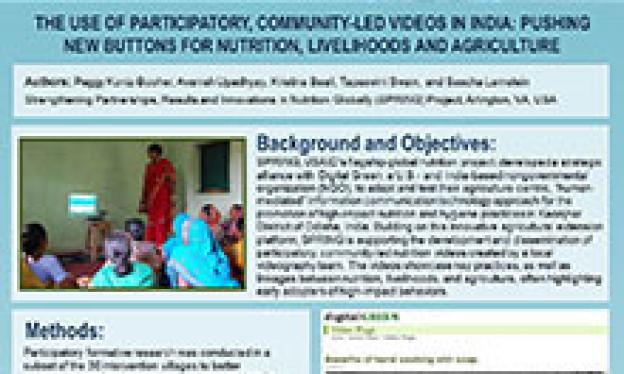Authors: Koniz-Booher P; Upadhyay, A; Beall, K; Swain, T; Lamstein, S
Background and objectives: SPRING, USAID’s flagship global nutrition project, has developed a strategic alliance with Digital Green, a US/India-based NGO, to adapt and test their agriculture-centric, “human-mediated" information communication technology approach for the promotion of high-impact nutrition and hygiene practices in Keonjhar District of Odisha, India. Building on this innovative agricultural extension platform, SPRING is supporting the development and dissemination of participatory, community-led nutrition videos created by a local videography team. The videos showcase key practices, as well as linkages between nutrition, livelihoods, and agriculture, often highlighting early adopters of high-impact behaviors.
Methods: Participatory formative research was conducted in a subset of the 30 intervention villages to better understand both barriers and community enablers for the adoption of key maternal, infant, and young child nutrition practices in these communities. Results also informed the selection and prioritization of video content, the identification of “actors” for the nutrition videos, and the design of nutrition trainings for the video production and dissemination teams.
After training, the local video team used low-cost video cameras and simple editing equipment to create ten nutrition videos, featuring mothers and other community members, speaking in their own language, about their experiences with selected practices. Battery-powered pico projectors are used for bi-weekly facilitated video disseminations, using a “dialogue” or “reflective” process among peers rather than a traditional nutrition education approach of outside “experts” informing clients
Results: Data on intention to adopt and verification of adoption of the key nutrition behaviors being promoted is routinely collected and reported through COCO (Connect On-line/Connect Off-line). Results are posted on the Digital Green website (www.digitalgreen.org) using a near-real-time analytical dashboard. Since dissemination began in April 2013, the nutrition video screenings have received positive feedback and generated requests for additional content from participating self-help group (SHG) members.
Knowledge retention has more than met initial expectations for the first five videos. Reported adoptions are highest for hand washing at 28.2% of SHG members, as this practice is relevant to a broader target audience, and IFA follows closely behind with 26.8% of SHG members adopting. Knowledge retention and adoption of more complex behaviors with narrow target audiences such as breastfeeding mothers is expectedly lower. According to captured data on the promotion of practices, promotions are currently more significant among family members than among neighbors.
Conclusions: This project highlights the potential of community video for fostering both social and individual behavior change with minimal technical input from external partners. Technically accurate video content has been successfully produced by local agents and widely disseminated, creating demand for more nutrition-related videos. The content is accepted by the communities and has promoted adoption of high-impact nutrition behaviors.
